By Timothy Hales | Updated: October 17, 2021
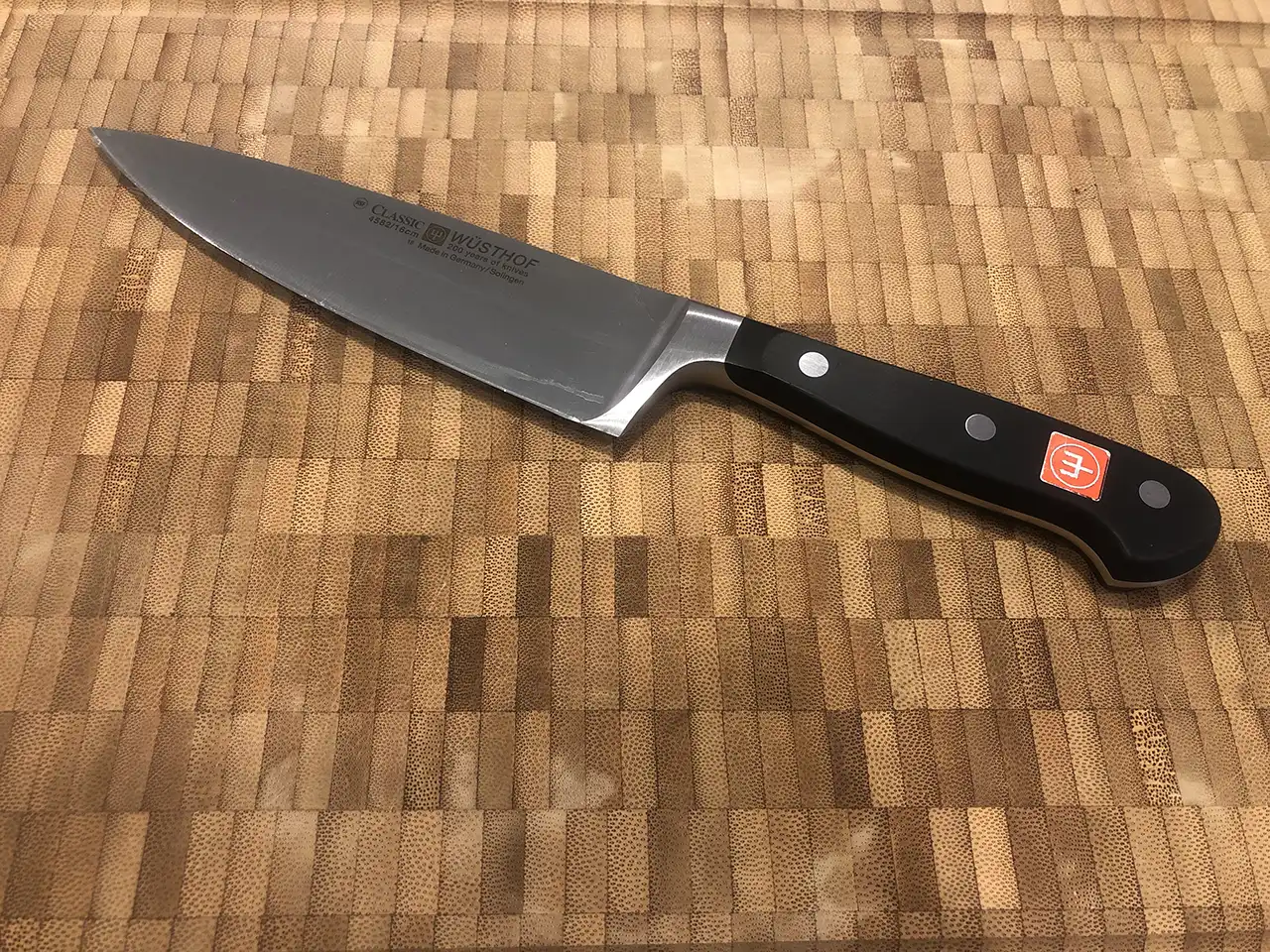
How long a kitchen knife lasts depends on various factors: Mainly the original quality of the knife and how well you take care of it. If you want your knife to last long, you will need to make sure you know how to maintain it properly. A high-quality knife that is adequately maintained has the potential to last a lifetime.
High-quality knives are essential kitchen tools and a worthy investment. Therefore, irrespective of the factors you must consider before purchasing a kitchen knife, its longevity is one of the primary considerations you must consider. If not—you’ll invest in a product that will fail to meet your needs after a short time.
If you want to make sure your kitchen knives last long, keep reading to find out.
Factors That Determine a Knife’s Quality
When researching a kitchen knife that will last a lifetime, you should consider the knife’s quality by knowing what materials are used to make the handle and the blade. These are the two main components of the knife that will cause you to fall in love with the knife or ultimately hate the knife.
Handle quality
Although you may think that the knife blade does all the work, you need to understand that a quality handle provides both comfort and safety when using your knife. You can break kitchen knife handles into two categories: natural materials and synthetic materials.
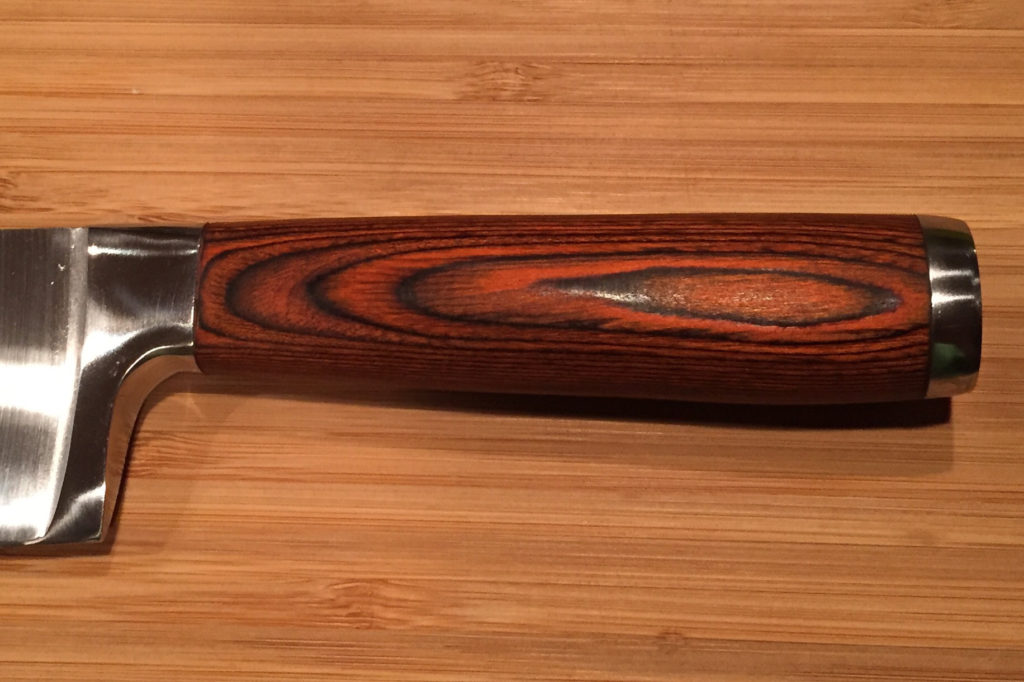
Natural materials include wood, metal, and bone. These materials tend to require a little extra care as temperature changes and exposure to moisture can cause the handle to break down. Yes, these handles can add exquisite beauty to your knife, but they are not ideal for keeping up with everyday use.
Synthetic materials include plastic, resin, and other composites. These materials are more durable and come in a variety of shapes, sizes, and colors. These handles are ideal for everyday use as they can withstand the demands of a busy kitchen.
Blade quality
Now that you have a better understanding of handle options let’s look at blade quality. There are different viewpoints on what knife blade quality means, but in this article, we will consider its hardness, edge retention, and corrosion resistance. The meaning of these terms may be unclear to you, so we will briefly describe each one.
- Hardness is measured on a Rockwell Harness scale and determines the blade’s ability to resist chips, breaks, and deformations when under varying types of force.
- Edge retention is how long a knife blade can remain sharp. The harder the blade, the longer the edge will remain sharp; however, this also means that the blade can chip more easily. Harder blades can also be more difficult to sharpen as compared to softer blades.
- Corrosion resistance is the blade’s ability to not rust. There are many reasons for a blade to break down and rust or have some type of chemical reaction. Water, salt, and acidic foods are just a few causes for a knife blade to rust.
Although you can try and find the best of each of these areas, it ultimately comes down to how well you maintain your kitchen knife blade.
Blade Construction
Knives are constructed in two ways, through being forged or stamped. Generally, forged knives are high-quality compared to stamped knives since they are created using extreme heat and eventually molded into the desired shape, unlike stamped knives made using machines. It’s best to pick a forged knife since it has a stronger blade.
Blade Material
Without a doubt, a knife’s material will affect its durability. Stainless steel is used to make most knives, but some of the more expensive knives are carbon steel. The difference between stainless steel and carbon steel is that chromium is added to stainless steel to help it maintain its ability to resist corrosion and rust.
How can you make your kitchen knives last longer?
After purchasing a kitchen knife, regular maintenance will determine its longevity. Below we have thoroughly explained proven tips to ensure your kitchen knives are in tip-top shape for an extended time.
Use knife blade oil on your knife
To ensure your knife remains in good shape, you can apply a few drops of kitchen knife blade oil on some handle types and the blade to ensure your knife doesn’t react to acidic foods such as lime and tomatoes.
Using mineral oil on your knife protects the chromium layer of your knife from acidic foods that destroy it, preventing rust and stains.
If you are using a carbon knife, it’s best to apply mineral oil after every use since it’s more prone to rust and stains.
Clean and dry your knife after each use
After using your knife, handwash it using dishwasher soap and water. You can use a soft sponge that won’t scratch the knife and don’t use an aluminum sponge since it can leave scratches on the knife.
Once it’s clean, dry your knife as soon as possible to avoid rust and stains.
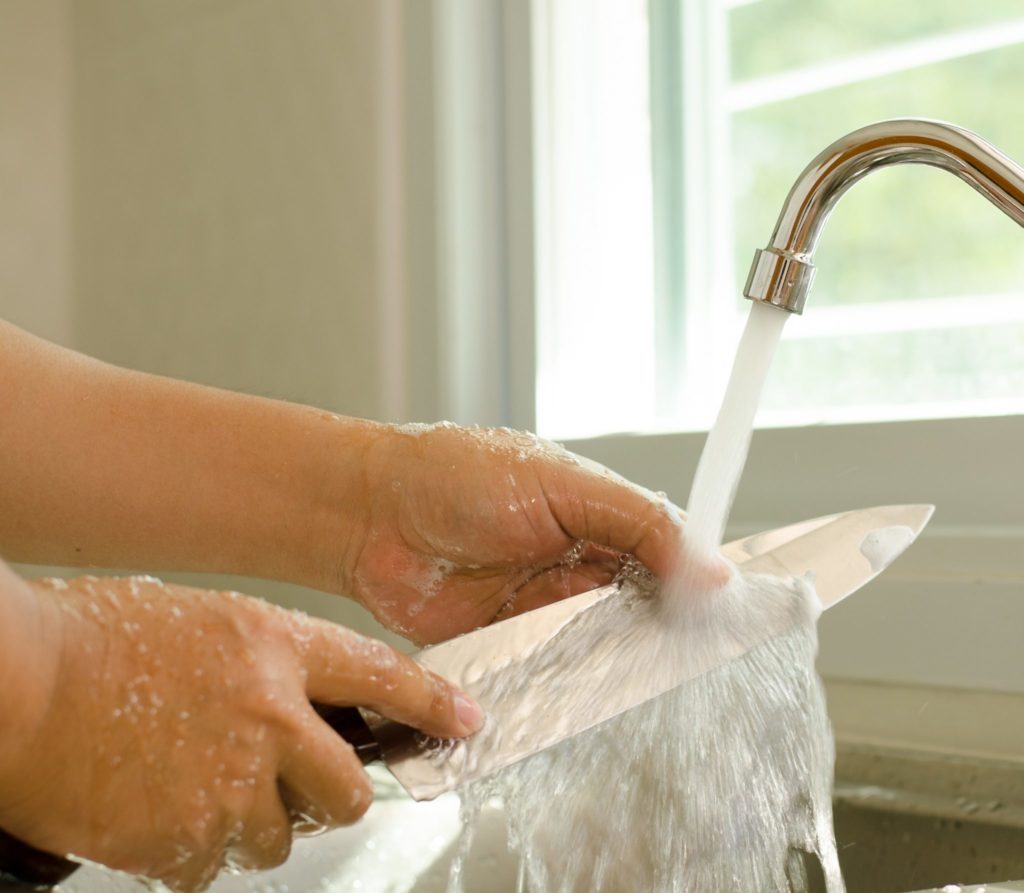
Properly store your knife
Don’t put your knives in a loose bin. Instead, you can use knife storage solutions made of magnets or block storage. If you don’t have a wall for these storage solutions, you can purchase knife guards.
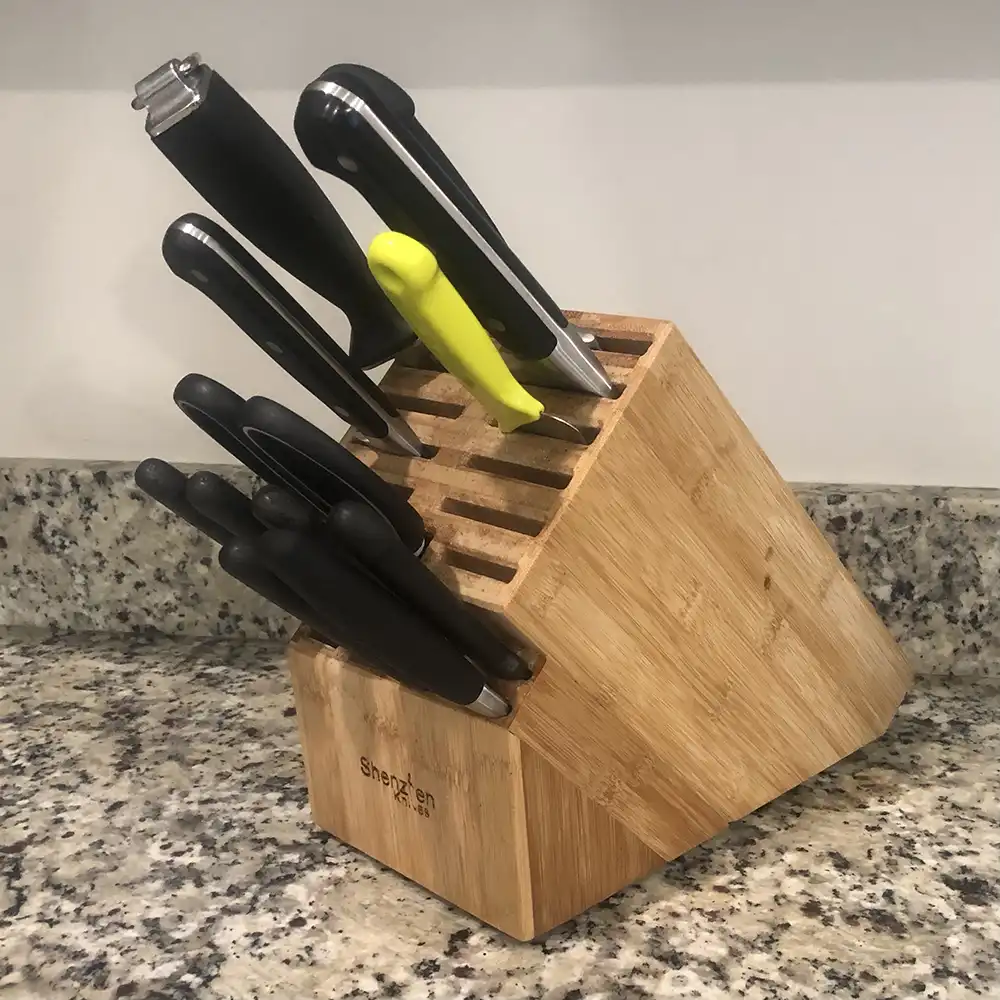
Don’t multitask using the knife
If you want to increase the lifespan of your knife, it’s best to use your knife on food alone. Don’t use it to open boxes, cans or cut through small animals such as poultry or fish. Doing this will chip your blade, making it dull and blunt.
It’s best to avoid using your knife for other purposes since it can damage your knife’s blade. If you want a knife for specific purposes, it’s best to invest in another knife that is designed for that particular task.
When Should You Replace Your Kitchen Knives?
Although a good quality chef knife can last a lifetime, there are some reasons why you should replace your kitchen knife:
1. Compatibility issues.
Kitchen knives do not always match up with the user. The best way to buy a chef knife is to go into a kitchen store and try them out. This is not always an option, so many people research and purchase online. Once you get the knife, you may find that the handle does not fit your hand, or the style of the blade does not work out for you. For example, purchasing a 10″ chef knife probably isn’t going to work well for cutting strawberries. In these cases, you should find another knife that better meets your needs.
2. Large chips in the blade.
Minor nicks and imperfections in the blade are very common if you use your knife at all. Fixing these smaller damaged areas is part of regular maintenance; however, fixing large chips in the blade can take a little more to repair. It requires grinding the blade to remove the material around the chip to create a smooth surface. Depending on the extent of damage and your accessibility to a repair service, you may find it easier to replace the knife.
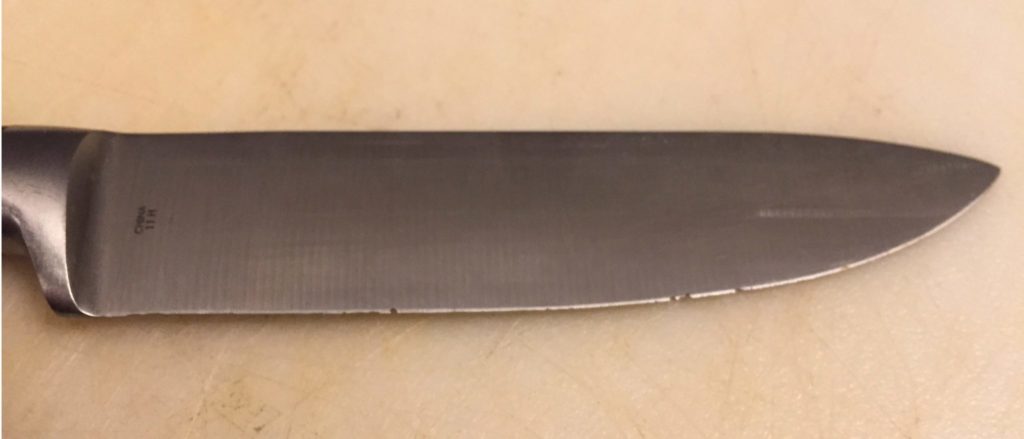
3. Tip of Knife blade bent or broken.
Chips in the blade are not the only damage that can happen to the knife blade. The knife blade tip can be bent or broken off completely, most commonly from dropping it on the floor or knocking it off the counter. You can also break the knife tip by cutting harder food such as those that are frozen.
Broken tips are one of the more difficult repairs to make on a knife. When the tip is missing, a new blade tip must be formed. This can take a significant amount of material off the knife which makes it shorter and can hinder its functionality. In certain cases, you may need to replace the knife completely.
4. Issues with knife handle.
A kitchen knife handle can have several different issues.
Most knife handles are held on to the blade’s tang using rivets. Rivets are round metal pieces that look like screws. If they become loose, then the handle can wabble and create a hazardous situation when cutting. Loose rivets can also cause the handle to come off entirely. If they are too loose to hold the handle to the blade, it’s time to replace your knife.
Lastly, if the handle falls off, you need to invest in a new knife. Cheap knives that have a stamped blade are known to have handles that work loose over time. The plastic handle just will not stay on any longer. In these cases, you should invest in a new knife.
If you are willing to put in the extra work, then carbon steel may interest you. It’s software material is easier to sharpen and hold a blade edge longer; however, it will quickly rust if you do not clean it immediately after use. Stainless steel is better for the home chef who may not clean their knives as quickly.
What Types of kitchen knives last longer?
If you are looking for the best kitchen knives to invest in, a chef’s knife and a Santoku knife will serve you for an extended period. Most experts recommend these knives since they are appropriate for different kitchen tasks. Furthermore, they are constructed in a way that guarantees durability.
Also, choosing a stainless steel knife is recommendable since they last longer, unlike carbon steel knives that are expensive but prone to rust and stains or Ceramic knives that are prone to chipping.
Conclusion
A kitchen knife is a fundamental kitchen tool. However, if you want your kitchen knife to last long, you need to maintain it regularly. Investing in a high-quality knife that will serve you for a long time is advisable.
Lastly, follow our tips and tricks to ensure your knives last longer. If you have more questions, leave a comment below.